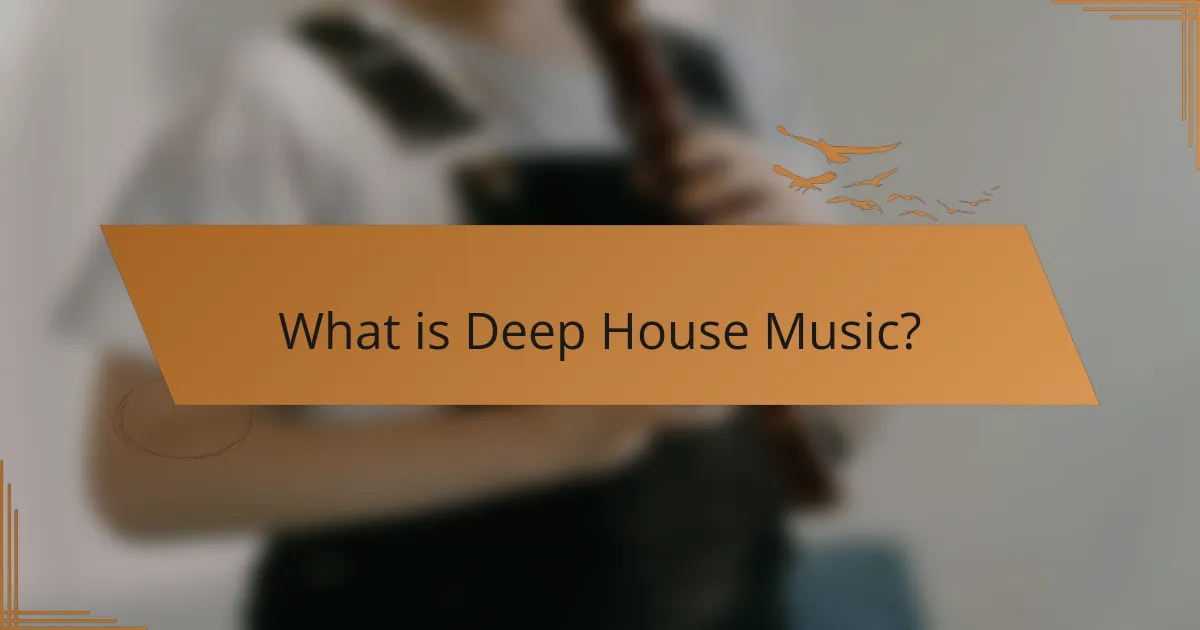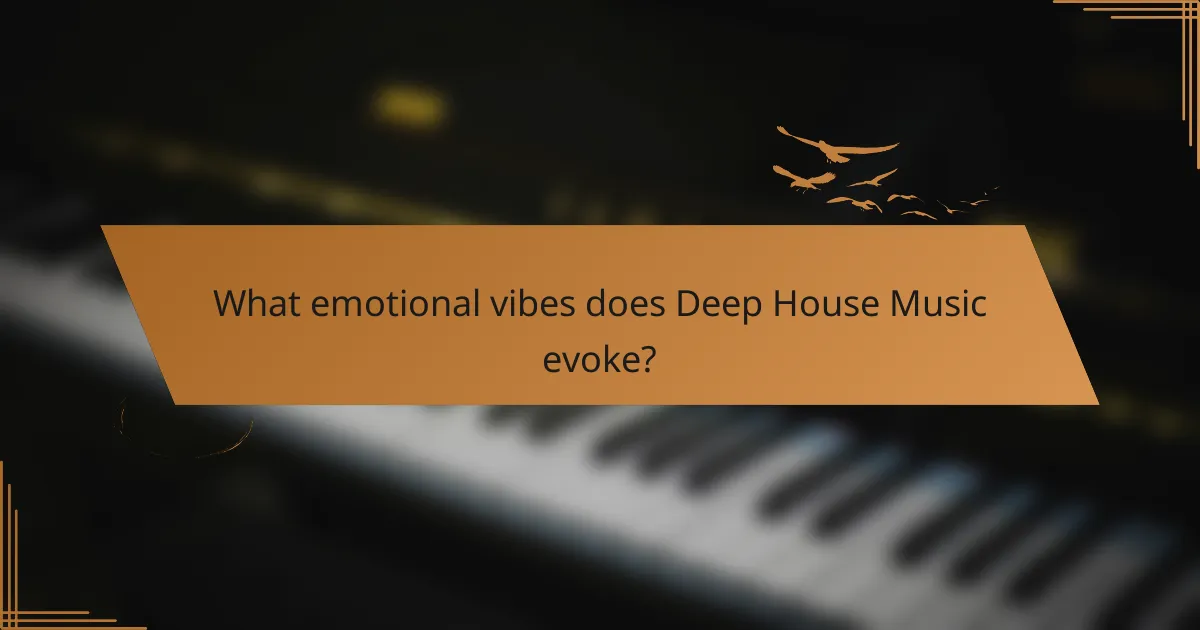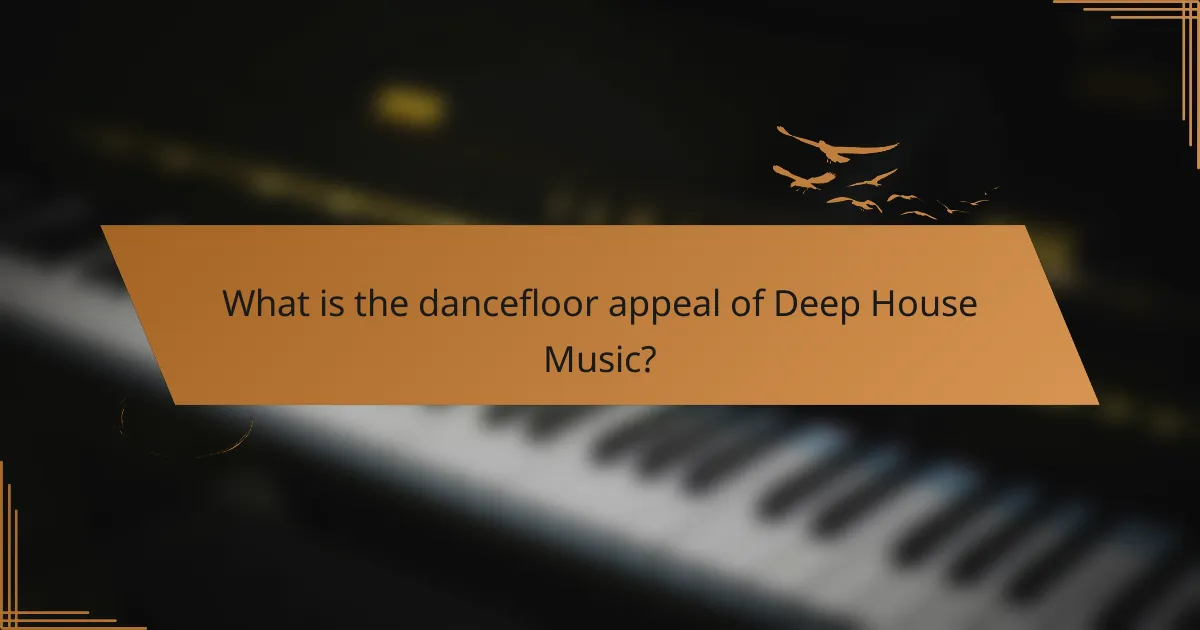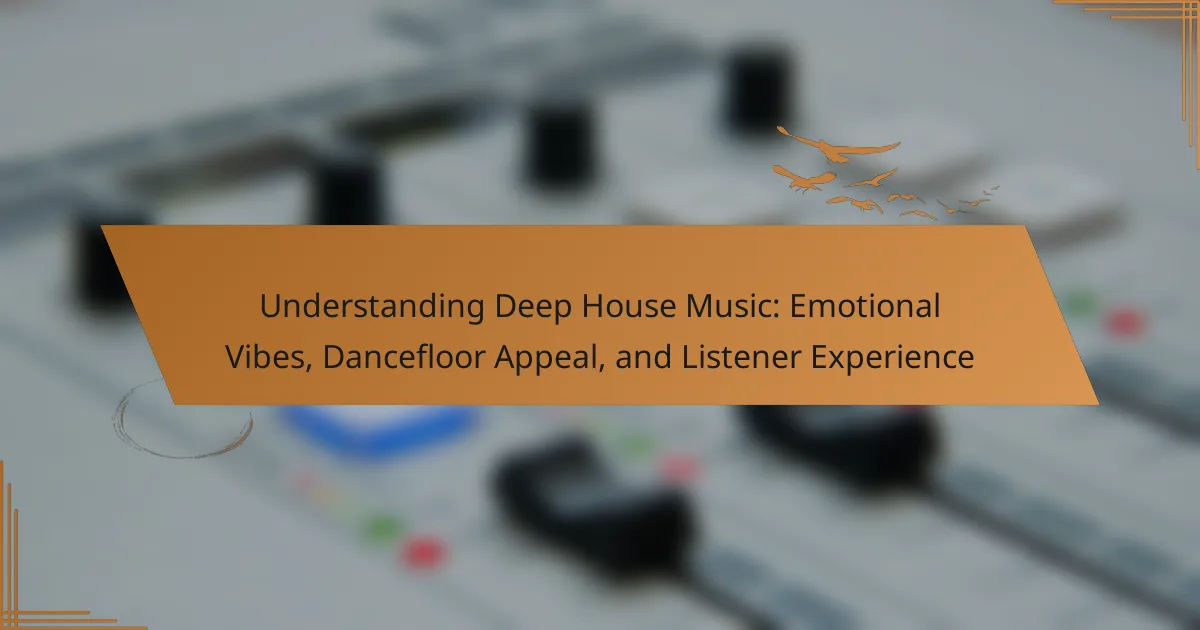Deep House Music is a subgenre of house music recognized for its smooth, mellow sound, characterized by complex melodies, soulful vocals, and deep basslines. Emerging in the 1980s, it blends elements of jazz, funk, and soul, with notable artists like Larry Heard and Kerri Chandler. The genre typically features slower tempos of 120 to 125 BPM, creating an immersive atmosphere that promotes emotional release and connection among listeners. Deep House Music’s appeal on the dancefloor is enhanced by its rhythmic elements and vocal samples, making it a popular choice in clubs and lounges, where it fosters a communal experience and emotional engagement.

What is Deep House Music?
Deep House Music is a subgenre of house music known for its smooth, mellow sound. It typically features complex melodies, soulful vocals, and deep basslines. The genre emerged in the 1980s, combining elements of jazz, funk, and soul. Notable artists include Larry Heard and Kerri Chandler. Deep house is characterized by slower tempos, usually ranging from 120 to 125 BPM. Its atmospheric qualities create an emotional vibe, making it popular in clubs and lounges. The genre has gained significant popularity in recent years, influencing various music styles and cultures.
How did Deep House Music originate?
Deep House Music originated in the 1980s as a subgenre of house music. It emerged primarily from Chicago and Detroit’s vibrant music scenes. Influences included jazz, soul, and funk, which shaped its unique sound. Notable producers like Larry Heard contributed significantly to its development. Deep house is characterized by its smooth, melodic elements and slower tempo. The genre gained popularity in clubs and underground scenes, fostering a dedicated following. By the 1990s, it had spread globally, influencing various artists and music styles. Today, deep house remains a staple in electronic dance music culture.
What cultural influences shaped the beginnings of Deep House Music?
Deep House Music originated from a blend of various cultural influences. Chicago’s house music scene in the 1980s significantly impacted its development. The incorporation of soulful vocals and jazz elements was prevalent in early tracks. African American culture played a crucial role in shaping its sound and aesthetic. Additionally, the use of synthesizers and drum machines reflected the technological advancements of that era. European electronic music, particularly from the UK and Germany, also contributed to its evolution. The fusion of these diverse influences created a unique genre that emphasized emotional depth and groove.
Who were the key pioneers in the development of Deep House Music?
Key pioneers in the development of Deep House Music include Larry Heard, Frankie Knuckles, and Jesse Saunders. Larry Heard, also known as Mr. Fingers, is credited with creating the genre’s signature sound in the mid-1980s. Frankie Knuckles, often referred to as the “Godfather of House,” played a crucial role in popularizing Deep House in Chicago. Jesse Saunders produced one of the first house records, “On and On,” which laid the groundwork for the genre. These artists significantly influenced the evolution of Deep House through their innovative production techniques and unique musical styles.
What are the defining characteristics of Deep House Music?
Deep House Music is characterized by its smooth, soulful sound and deep basslines. It typically features slower tempos, ranging from 120 to 125 BPM. The genre often incorporates elements of jazz, funk, and soul, creating a rich musical texture. Vocals in deep house tracks are usually soft and emotive, adding to the overall atmosphere. Synthesizers and electronic instruments are prominently used to create lush soundscapes. The production style often emphasizes warmth and depth, contributing to its immersive quality. Deep house music emerged in the 1980s and has evolved, influencing various sub-genres. Its appeal lies in its ability to evoke emotions while maintaining a danceable rhythm.
What elements contribute to the sound of Deep House Music?
Deep House Music is characterized by several key elements that define its sound. The genre features a smooth, soulful vocal style that often incorporates jazz and funk influences. A prominent bassline provides depth and groove, typically using deep, subby sounds. Chords are often lush and atmospheric, creating an immersive listening experience.
The tempo of Deep House generally ranges from 120 to 125 BPM, contributing to its laid-back feel. Drum patterns are usually minimalistic, focusing on a four-on-the-floor kick drum with added hi-hats and claps. Synthesizers are frequently used to create melodic hooks and ambient textures.
Additionally, the use of samples from various genres can add unique flavors to the tracks. Overall, these elements work together to create the distinctive sound that defines Deep House Music.
How does tempo influence the vibe of Deep House Music?
Tempo significantly influences the vibe of Deep House Music. Typically, Deep House features a tempo range of 120 to 125 beats per minute. This moderate tempo creates a relaxed yet engaging atmosphere. It encourages a sense of groove and flow, making it suitable for both listening and dancing. The steady rhythm allows for intricate basslines and melodic elements to shine. As a result, the music evokes emotions like calmness and introspection. The tempo also facilitates smooth transitions between tracks in a DJ set. This consistency enhances the overall experience for listeners and dancers alike.

What emotional vibes does Deep House Music evoke?
Deep House Music evokes feelings of relaxation, nostalgia, and euphoria. The genre is characterized by its smooth, melodic elements and deep basslines. These musical components create a soothing atmosphere that promotes emotional release. Many listeners report experiencing a sense of connection and introspection while engaging with Deep House tracks. The repetitive beats contribute to a trance-like state, enhancing feelings of joy and contentment. Research indicates that music with a slower tempo, like Deep House, can reduce stress and anxiety levels. This emotional impact is often amplified in social settings, like dance clubs, where collective experiences enhance individual feelings.
How does Deep House Music create an emotional connection with listeners?
Deep House Music creates an emotional connection with listeners through its rich melodies and deep basslines. The genre often incorporates soulful vocals and atmospheric sounds. These elements evoke feelings of nostalgia and introspection. The tempo typically ranges from 120 to 125 BPM, promoting a relaxed yet engaging vibe. This rhythm encourages listeners to immerse themselves in the music. Additionally, the repetitive nature of deep house tracks fosters a trance-like state. Research indicates that music with emotional depth can trigger the release of dopamine, enhancing listener enjoyment. This emotional resonance is a key reason why deep house is popular in social settings like clubs and festivals.
What specific emotions are commonly associated with Deep House Music?
Deep House Music is commonly associated with emotions such as relaxation, euphoria, and introspection. The genre often features smooth, melodic sounds that create a calming atmosphere. This tranquil vibe fosters a sense of peace and comfort among listeners. Euphoria is frequently experienced during uplifting tracks that encourage dancing and connection. Introspection is enhanced by deep basslines and soulful vocals that provoke thoughtful reflection. Studies show that music with repetitive structures, like Deep House, can evoke strong emotional responses. The combination of these elements makes Deep House a unique emotional experience for listeners.
How do lyrics and melodies enhance emotional experiences in Deep House Music?
Lyrics and melodies in Deep House Music significantly enhance emotional experiences. Lyrics often convey themes of love, longing, and introspection. These themes resonate deeply with listeners, evoking personal memories and feelings. Melodies in Deep House are typically smooth and flowing, creating a soothing atmosphere. This soundscape encourages emotional reflection and connection. The combination of rhythmic basslines and melodic elements fosters a sense of euphoria. Research indicates that music with emotional lyrics can trigger emotional responses in listeners (Brattico et al., 2016, “The Role of Music in Emotion Regulation”). Together, lyrics and melodies create a rich emotional tapestry that enhances the overall listening experience.
Why is Deep House Music popular in social settings?
Deep House Music is popular in social settings due to its rhythmic beats and soothing melodies. The genre creates an inviting atmosphere that encourages social interaction. Its tempo typically ranges from 120 to 125 BPM, making it suitable for dancing. Deep House often incorporates soulful vocals and jazz influences, enhancing emotional connectivity among listeners. Research indicates that music with a steady beat can increase social bonding. Additionally, its repetitive structure allows for easy conversation without overwhelming background noise. These characteristics make Deep House a preferred choice for clubs, lounges, and social gatherings.
What role does Deep House Music play in nightlife and parties?
Deep House Music serves as a pivotal element in nightlife and parties. It creates a relaxed yet energetic atmosphere that encourages social interaction. The genre’s smooth rhythms and soulful melodies resonate with partygoers. This fosters a sense of connection and emotional engagement among listeners. Deep House tracks often feature deep basslines and intricate layers, enhancing the dancefloor experience. Research indicates that music influences mood and behavior, making Deep House effective for sustaining energy levels. Venues frequently choose Deep House to maintain a vibrant ambiance throughout the night. Its popularity in clubs and festivals underscores its significance in contemporary nightlife.
How do DJs curate Deep House Music for optimal emotional impact?
DJs curate Deep House Music for optimal emotional impact by selecting tracks that evoke specific feelings. They analyze the emotional tone of each song. This includes assessing elements like melody, harmony, and rhythm. DJs often blend tracks with similar keys and tempos to maintain a cohesive vibe. They also pay attention to the dynamics and structure of tracks. Building tension and release throughout a set enhances emotional engagement. Additionally, DJs consider the audience’s reactions and adjust their selections accordingly. Research shows that music can significantly influence mood and emotional states. This understanding helps DJs create memorable experiences on the dancefloor.

What is the dancefloor appeal of Deep House Music?
Deep House Music has a strong dancefloor appeal due to its smooth, soulful sound and rhythmic basslines. This genre often features deep, melodic elements that create an immersive atmosphere. The tempo typically ranges from 120 to 125 BPM, which encourages movement and dancing. Its use of repetitive beats allows dancers to lose themselves in the music. Additionally, Deep House often incorporates vocal samples that add emotional depth. The genre’s blend of house, jazz, and funk influences makes it versatile for various settings. Events featuring Deep House music often attract diverse crowds, enhancing the communal experience on the dancefloor. Overall, its ability to evoke feelings and encourage movement solidifies its appeal in nightlife scenes.
How does Deep House Music engage dancers?
Deep House Music engages dancers through its rhythmic beats and immersive melodies. The genre typically features a tempo between 120 to 125 BPM, which encourages movement. Deep basslines create a physical connection, allowing dancers to feel the music in their bodies. The use of soulful vocals adds an emotional layer, enhancing the overall experience.
Additionally, atmospheric pads and intricate synths create a rich soundscape that captivates listeners. This complexity invites dancers to lose themselves in the music. The repetitive nature of the tracks fosters a trance-like state, promoting prolonged dancing.
Research indicates that music with a strong beat can increase physical activity levels, making Deep House particularly effective for engaging dancers. The combination of these elements results in a vibrant dancefloor atmosphere, where connection and expression thrive.
What rhythmic elements encourage movement in Deep House Music?
Four-on-the-floor beats are a primary rhythmic element that encourages movement in Deep House Music. This rhythmic pattern features a bass drum hitting on every beat in 4/4 time. It creates a steady pulse that is easy for listeners to follow. Syncopated hi-hats and claps add complexity and drive. These elements create a sense of groove that invites dancing. Additionally, deep basslines provide a rich foundation that enhances the overall rhythm. The combination of these elements fosters an engaging atmosphere on the dancefloor. Many tracks utilize these rhythmic structures to maintain energy and encourage movement throughout the song.
How does the atmosphere created by Deep House Music affect dance styles?
Deep House Music creates a relaxed and immersive atmosphere that influences dance styles. The genre’s smooth melodies and deep basslines encourage fluid movements. Dancers often adopt a more expressive style, reflecting the emotional depth of the music. The slow tempo allows for intricate footwork and body movements. This atmosphere fosters a sense of connection among dancers, enhancing group dynamics. Research indicates that music tempo and rhythm significantly impact movement quality and style. A study by D. F. S. L. Silva et al. in “Music Perception” highlights how different musical elements shape dance interpretation. Thus, the atmosphere of Deep House Music directly affects the way individuals express themselves through dance.
Why do people choose Deep House Music over other genres for dancing?
People choose Deep House Music over other genres for dancing due to its unique rhythmic qualities and emotional depth. The genre features a consistent beat that allows for fluid movement. Its melodic elements create an immersive atmosphere that enhances the dancing experience. Deep House often incorporates soulful vocals and intricate harmonies, which resonate emotionally with listeners. This emotional connection encourages longer dance sessions. Research shows that the genre’s tempo, typically between 120-125 BPM, aligns well with human movement patterns. This makes it easier for dancers to maintain energy and stamina on the dance floor. Overall, the combination of rhythm, melody, and emotional engagement makes Deep House a preferred choice for dancing.
What unique qualities of Deep House Music attract dancers?
Deep House Music attracts dancers with its smooth, melodic elements and rhythmic basslines. The genre features soulful vocals and intricate harmonies. These qualities create an emotional connection that enhances the dance experience. The consistent tempo, usually between 120 to 125 BPM, allows for fluid movement. Deep House tracks often include atmospheric sounds, promoting a relaxed yet engaging atmosphere. This combination encourages dancers to lose themselves in the music. Research shows that emotional resonance in music significantly influences movement and dance enjoyment. Therefore, the unique qualities of Deep House Music effectively draw dancers to the floor.
How does Deep House Music facilitate social interaction on the dancefloor?
Deep House Music facilitates social interaction on the dancefloor by creating an immersive atmosphere. Its rhythmic beats and melodic elements encourage movement and connection among dancers. The genre often features extended tracks, allowing for a shared experience over time. This extended play promotes a sense of unity as individuals engage in a collective rhythm.
The emotional depth of Deep House Music evokes feelings that enhance social bonding. Tracks often include soulful vocals and harmonies that resonate with listeners. This emotional resonance fosters communication and interaction among people. Research indicates that music with a strong emotional component enhances social cohesion in group settings.
In clubs and festivals, Deep House Music sets a welcoming tone. The genre’s laid-back vibe encourages people to let loose and engage with one another. Studies show that environments with specific music genres can influence social behavior positively. Thus, Deep House Music not only entertains but also serves as a catalyst for social interaction on the dancefloor.
What are the best practices for experiencing Deep House Music live?
To experience Deep House Music live, prioritize venue selection. Choose intimate spaces that enhance the emotional connection. Engage with the DJ to appreciate their unique style. Arrive early to secure a good spot for optimal sound. Immerse yourself in the atmosphere by embracing the visual elements. Connect with fellow attendees to enhance the communal vibe. Stay hydrated and take breaks to maintain energy levels. Respect the music and others to foster a positive environment. These practices enhance the overall experience of Deep House Music live events.
How can listeners enhance their experience at Deep House Music events?
Listeners can enhance their experience at Deep House Music events by engaging with the music and the environment. Active participation, such as dancing and connecting with others, increases enjoyment. Arriving early allows attendees to acclimate to the venue and set a positive mood. Dressing comfortably is essential for prolonged enjoyment on the dancefloor. Staying hydrated helps maintain energy levels throughout the event. Exploring different areas of the venue can provide varied auditory experiences. Engaging with the DJ and fellow attendees fosters a sense of community. Finally, being open to new sounds and experiences enhances overall satisfaction. These actions contribute to a richer, more immersive experience at Deep House Music events.
What tips can improve one’s appreciation of Deep House Music in a social context?
Engaging with Deep House Music in social settings can be enhanced through active listening. Focus on the intricate layers of sound within tracks. Observe how the music influences the atmosphere and mood of the gathering. Participate in conversations about the genre’s history and its notable artists. Attend live events or parties where Deep House is played to experience the communal vibe. Sharing personal interpretations of tracks with others can deepen appreciation. Exploring sub-genres and related styles can broaden understanding. Lastly, consider the emotional responses elicited by different tracks to connect on a deeper level.
Deep House Music is a subgenre of house music characterized by its smooth, mellow sound, complex melodies, soulful vocals, and deep basslines. Originating in the 1980s, it blends elements of jazz, funk, and soul, creating an emotional atmosphere that resonates with listeners. The article explores the cultural influences that shaped Deep House, key pioneers in its development, and the defining characteristics that contribute to its dancefloor appeal. Additionally, it examines the emotional connections fostered by the genre, factors influencing listener experiences, and best practices for enjoying Deep House Music in social settings.
